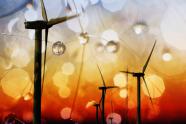Green Energy Faces Nat Gas Issues
Supply Lines in Short Supply

Natural gas is seen as the bridge to solving the
intermittency of supply issues that renewable energy
faces as it contends to take an ever-larger share of
the generation load. But is there enough
infrastructure available to get gas to peaking and
other plants when wind and solar resources
inevitably back off? And, if there aren’t who pays
for the new supply lines?
An international consultancy started thinking about
those questions and wrote a white paper that
presents different scenarios related to the topic.
ICF International wrote “Integrating Variable
Renewable Electric Power Generators and the Natural
Gas Infrastructure,” to explore the implications of
increased renewable penetration.
“There really hasn’t been a lot of public dialogue
about this,” Steve Fine, one of the paper’s authors
told this reporter.
ICF said it finds that natural gas will play a
significant role in supporting the continued
expansion of renewable generation, which will have
impacts in the form of operational changes,
infrastructure requirements, and cost recovery
issues.
New facilities may need to be constructed at some
locations to guarantee reliable on-demand gas
service to support changing generator needs
resulting from increased renewable generation, the
firm adds.
“As we continue to roll out more renewables onto the
power grid, we’re going to have the need for
additional fast ramping capability,” Fine said. “And
we have to think about who pays for the gas service
that we need for those new generators.”
For example, if a new gas line is needed to serve
plants that back up renewables but also it is used
transport gas for home or commercial heating, who
pays how much, or what share of the recovery for the
owner? That isn’t a question that has been addressed
yet, to the report authors’ knowledge.
Scenarios
ICF described three hypothetical power industry
scenarios that illustrate the potential impacts of
variable renewable generation on natural gas-fired
power plants and gas infrastructure. Scenario I
addresses long-term utility planning, in which
utilities plan to meet 800 MW of demand growth with
gas-fired capacity, but changing circumstances
result in 800 MW of wind additions.
Scenario II
looks at utility Renewable Portfolio Standard (RPS)
planning, in which utilities add 800 MW of wind to
meet RPS requirements in the absence of forecast
electric load growth.
Scenario III differs from the first two scenarios in
that the integration is not handled in the context
of a utility system with supply and demand
interactions. Rather, the renewable
producers─because of contractual, regulatory, and/or
system conditions─must arrange to eliminate the
deviation in wind output from forecasted output
within a day or less.
The question could be particularly acute on the
coasts.
In California, an aggressive 33 percent renewable
portfolio standard could rely on increased gas
generation to augment wind and solar plants.
In New England, already at the end of a long gas
pipe, heavy reliance on natural gas for electricity
and winter heating often stretches available
supplies, even while RPS targets are low.
Fortunately, there are a few years to work this out.
But it’s something regulators will need to address
eventually.
Copyright © 1996-2011 by CyberTech, Inc. All rights reserved.
To subscribe or visit go to: http://www.energycentral.com
To subscribe or visit go to: http://www.energybiz.com